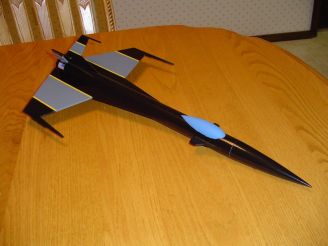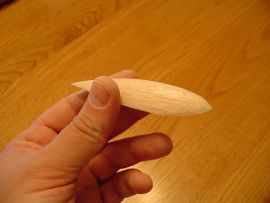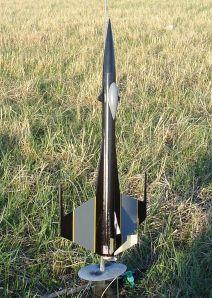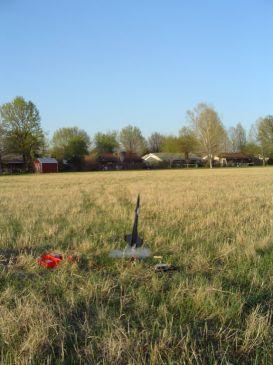Thrustline Aerospace F-19 Night Fighter
Thrustline Aerospace - F-19 Night Fighter {Kit}
Contributed by Todd Mullin
| Construction Rating: | starstarstarstarstar_border |
| Flight Rating: | starstarstarstarstar |
| Overall Rating: | starstarstarstarstar_border |
| Manufacturer: | Thrustline Aerospace |

Brief:
Single stage futuristic, jet fighter styled model rocket.
Construction:
Single glassine wrapped paper body tube, balsa nose cone, two main
"wing" fins, two "vertical stab" fins, two canard fins, and
two rear sub fins. Carved balsa canopy. Standard modroc motor mount with 2
laser cut black fiber board centering rings and 24mm paper tube w/ engine clip
to fit standard 2.75" long "D" motors. 18" Mylar parachute.
Kevlar®
thread and 1/4" wide elastic shock cord attached to MMT.
The instructions were very complete and easy to follow. Numerous pictures to explain the important steps. The fin templates are printed on heavier card stock and a tube marking wrap was included.
It was a challenging build due to the number and size of the fins/wings. You must pay careful attention to alignment when gluing on the various fins/wings. The parts included are of high quality.
The only "gotcha" would be the canopy. Three pieces of balsa sheet are glued together to make a block. A template is included to so you can mark the canopy's basic profile. It is a bit of work to shape the canopy, but if you take your time and follow the tips given in the instructions, you will be rewarded with a fine looking piece of hand shaped balsa. This is definitely a "builder's" kit.


Finishing:
No special techniques required for finishing. Pick you favorite. I filled the
wood and tube spirals with Elmer's Fill 'n' Finish. A couple of coats of
Rustoleum gray primer, sanding in between coats. Final finish is two coats of
Krylon gloss black, leaving stripes of the flat primer, accented with yellow
stripes on the gray borders. The finished product is sort of an
"X-Plane" theme.
About the only thing missing would be nice set of decals. A pre-formed canopy would make the build go faster.
Construction Rating: 4 out of 5

Flight:
Flight prep is standard stuff. A motor clip retains the motor. A handful of
"dog barf" wadding, fold the chute, and pack it in. Launch lugs are
1/8" diameter.
The first flight was on an Estes C11-5. It left the pad with authority on the C11. There was a slight 5mph breeze that day. At approximately 300 feet it started to weather vane into the wind at about a 45 deg angle. The delay was a bit long and made for an exciting dive before the chute opened. Definitely a rocket for calm days.
The second flight was on a D12-5. Much better flight. Not as much weathercocking.
Recovery:
The shock cord is the popular Kevlar®
thread attached to the MMT, extending out past the end of the body tube where
it is attached to an elastic shock cord to the nose cone. The mylar chute is
attached to the nose cone eyelet with a snap clip swivel.
 Recovery
went well. It comes down slow but all the fin surface does make for a lot of
drift. Even with a late ejection on the C11-5, the rocket suffered no damage
during the recovery.
Recovery
went well. It comes down slow but all the fin surface does make for a lot of
drift. Even with a late ejection on the C11-5, the rocket suffered no damage
during the recovery.
Flight Rating: 5 out of 5
Summary:
The main thing with this rocket is the look. It has the "cool" factor
in abundance.
No real cons. The complex fin alignment and canopy carving makes this a builder's kit. Not for the inexperienced.
Overall Rating: 4 out of 5
Other Reviews
- Thrustline Aerospace F-19 Night Fighter By Todd Mullin (February 24, 2007)
Brief: In the early days of rocketry if you wanted a rocket that looked like a jet, it was a Centuri kit for you. Thrustline's F-19 Night Fighter is a futuristic fighter aircraft styled rocket that once again delivers the kind of feel that could be found with these kits. The F-19 boosts on a single 24mm motor and recovers by parachute. Construction: All of the component of the ...
 |
 |
Flights
Sponsored Ads
 |
 |











